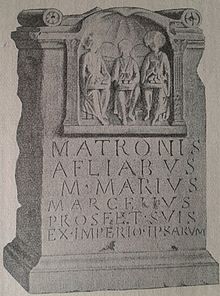Revelation inscription
The concept of revelation inscriptions comes from modern antiquity and describes a relatively small group of Latin dedicatory inscriptions from the time of the high Roman imperial era to late antiquity . The distribution area of these inscriptions is conspicuously concentrated in the area of the Rhenish provinces of Germania inferior and Germania superior with well over 100 inscriptions. Another high number of inscriptions was found in the imperial capital Rome , in the other regions or provinces only a few scattered individual finds are recorded.
This group is characterized by a specific consecration form, in which the founder motivated the making and setting up of a votive stone at the behest or inducement or exhortation of a deity . Formulas that identify revelation inscriptions as such are:
- ex imperio
- ex iussu
- ex visu
- ex praecepto
- vis (s) u iussus
Within the inscription corpus of the Roman Germania provinces, the dedicatory inscriptions for matrons show a revelatory character and here again almost exclusively with the formula ex imperio = on command, ruling order . The ex Visu inscriptions indicate that the donors believed they had received the command or instruction ( iussu ) of the deity in a dream.
Another characteristic of the revelation inscriptions in Germania is a relative ethnic attribution of the consecration stones or the dedicants . Romans paid for their vote in money, never at the request of a deity, and consequently marked this in the inscriptions with the abbreviation vslm = votum solvit libens (laetus) merito ("he / she redeemed the vow gladly and for a fee") ). The command of a deity therefore excludes a conventional “Roman” genuine vote and marks the inscriptions as coming from native (Germanic) contexts. Numerous revelation inscriptions end conspicuously with lm (vulgo libens merito ), so that this form is considered a suitable conclusion and furthermore with fragmentary traditional inscriptions where an lm can only be read in the closing sequence , without a revelation formula there can be a revelation inscription.
Examples of revelation inscriptions on deities in the Lower Rhine Inscription Catalog are:
"Matronis Afliabus Marcus Marius Marcellus pro se et suis ex imperio ipsarum"
" Alateiviae ex iussu Divos medicus"
" Marti sacrum ex visu Secundinius Martius libens laetus posuit"
"Deae Hurstrg (a) e ex praecepto eius Valerius New Year's Eve decurio municipii Batavorum posuit libens merito."
See also
literature
- A. Beck: The Latin revelation inscriptions of Roman Germania. In: Mainzer Zeitschrift 31 (1936), pp. 23–32.
- Wolfgang Spickermann , Heinz H. Steenken: Roman religion. In: Henry Beck, Dieter Geuenich, Heiko control (ed.): Germanische Altertumskunde Online , Volume 25, Walter de Gruyter, Berlin / New York 2003, pp 112-125 ( fee Germanic archeology online by de Gruyter).
- Wolfgang Spickermann: consecrated monuments. In: Henry Beck, Dieter Geuenich, Heiko control (ed.): Germanische Altertumskunde Online , Volume 33. Walter de Gruyter, Berlin / New York 2006, pp 370-373 ( fee Germanic archeology online by de Gruyter).
- BH Stolte : The religious conditions in Lower Germany. In: Wolfgang Haase (Ed.): Rise and decline of the Roman world , Vol. II 18, 1 Religion (Heidentum: The religious conditions in the provinces) . Walter de Gruyter, Berlin / New York 1986, ISBN 3-11-010050-9 , pp. 591-671; here 662ff. ( chargeable )
